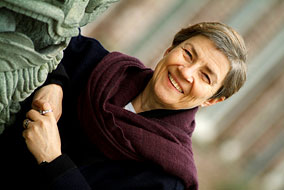
People are emotionally ready to do good; just make it easy for them, advises Freda Pagani - photo by Darin Dueck UBC Reports | Vol. 52 | No. 4 | Apr. 6, 2006
Beating the Kyoto Targets
How a community of 50,000 is learning to tread more lightly on the earth
By Lorraine Chan
In 1997, UBC was the first Canadian university to adopt a sustainability development policy. In 1998, UBC opened the Campus Sustainability Office (CSO) -- the first of its kind, as well.
Eight years later, student, faculty and staff efforts are seeing results. They have helped UBC’s Vancouver campus surpass Canada’s 2012 Kyoto Protocol targets, having reduced over the past 16 years greenhouse gas emissions by 25 per cent. And last year, UBC was Canada’s first and only university to receive Green Campus Recognition from the U.S.-based National Wildlife Federation.
How does a campus community of 50,000 organize itself to tread more lightly on the earth? CSO Director Freda Pagani says the secret lies in making it easy for students, staff and faculty to do good.
“People emotionally are ready to do something, but don’t know what,” says Pagani, who has steered CSO from the start. “Our role is to says here’s an easy thing you can do and it’s fun.”
Since 1999, despite a 24 per cent increase in students, UBC has reduced energy use in campus buildings by 10 per cent - saving $8 million. As well, UBC has cut down on water use by 32 per cent, enough to supply 14,700 homes for a year.
Since 1997, UBC has seen transit ridership increase by 140 per cent - now at more than 50,000 daily users - and single-occupant vehicle traffic decrease by 18 per cent per capita. This has been largely through initiatives like U-Pass that provides all students with an affordable monthly transit pass and unlimited access to Translink bus, SeaBus and SkyTrain services. The U-Pass first became available in 2003 when UBC’s transportation planning department, formally known as TREK, partnered with the Alma Mater Society and TransLink.
Pagani, who holds a PhD in Resource Management and Environmental Studies, says the mindset of sustainability requires a radical shift in thinking, one that she sees happening at UBC. Her own turning point came in spearheading the concept of UBC’s C.K. Choi Building, which, upon its opening in 1996, won several awards and set new green benchmarks for the world.
“I was pretty depressed about the world and I was doing my bit to reuse plastic bags and turn off lights, but it didn’t feel like I was making enough of an impact.”
At that time, Pagani was working at UBC’s project development office. She decided that her next building project would demonstrate a green building. Pagani worked with a team of 30 architects, engineers, designers, administrators, who were told to dream big, but to bring the C.K.Choi Building in on budget and on time.
“That experience changed my life,” says Pagani. “At the end, everyone said that was the best project they’ve ever been in. Mostly because everyone felt we had given them permission to be creative, to be imaginative and to make a difference.”
Pagani was told that she would have to fund her own salary and CSO activities through energy savings. She devised ecotrek, one of the largest institutional retrofits in Canada. In 2002, UBC kicked off the $35-million-dollar program to save money and energy by upgrading mechanical and electrical systems in core campus buildings. By this year, ecotrek will reduce CO2 emissions by about 15,000 tonnes each year and generate annual savings of about $2.5 million.
By 2010, UBC aims to have another 20,000 people living on campus. The University Town Plan will develop eight residential and mixed-use neighborhoods featuring student, faculty and staff housing, university-related shops and services, a community centre, a school and a range of public amenities. The plan stipulates that at least 50 per cent of households must include one resident who works or studies at UBC, with an eye to reducing automobile traffic to and from campus.
Pagani says that UBC has adopted a five-year sustainability action plan to build on this momentum. Goals include integrating sustainability issues into research, teaching and curriculum.
But at the heart of all these efforts, says Pagani, is a deeper shift that’s slowly taking shape.
“We’ve made a good start with economic and environmental sustainability, but we’re still learning about community and how to treat each other.”
That aspect of sustainability will transform everything we do and think, says Pagani. “Connection is the key - our connection to each other and to the natural world.”
For more information about UBC’s sustainability initiatives, visit: www.sustain.ubc.ca, www.recycle.ubc.ca, www.trek.ubc.ca.
|
